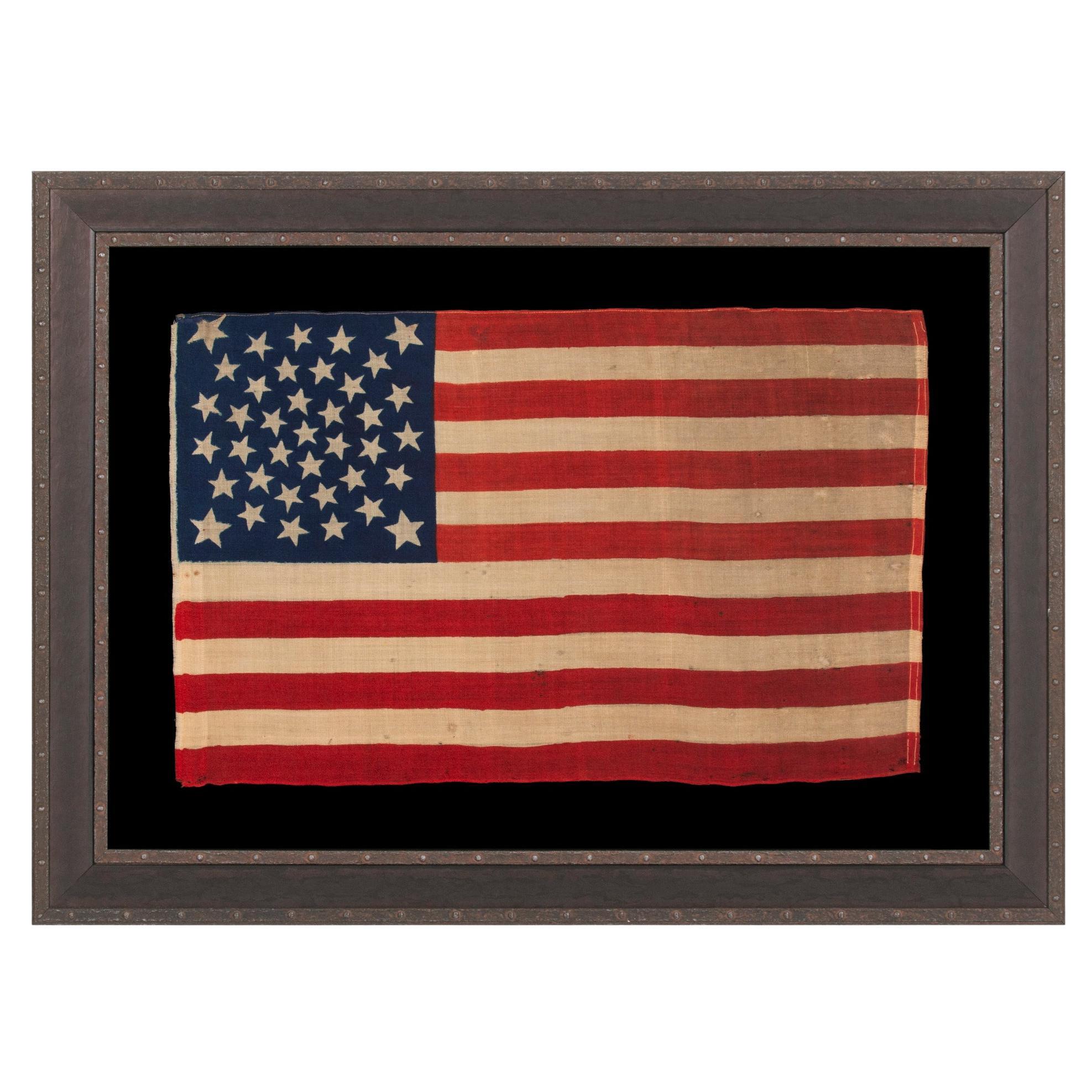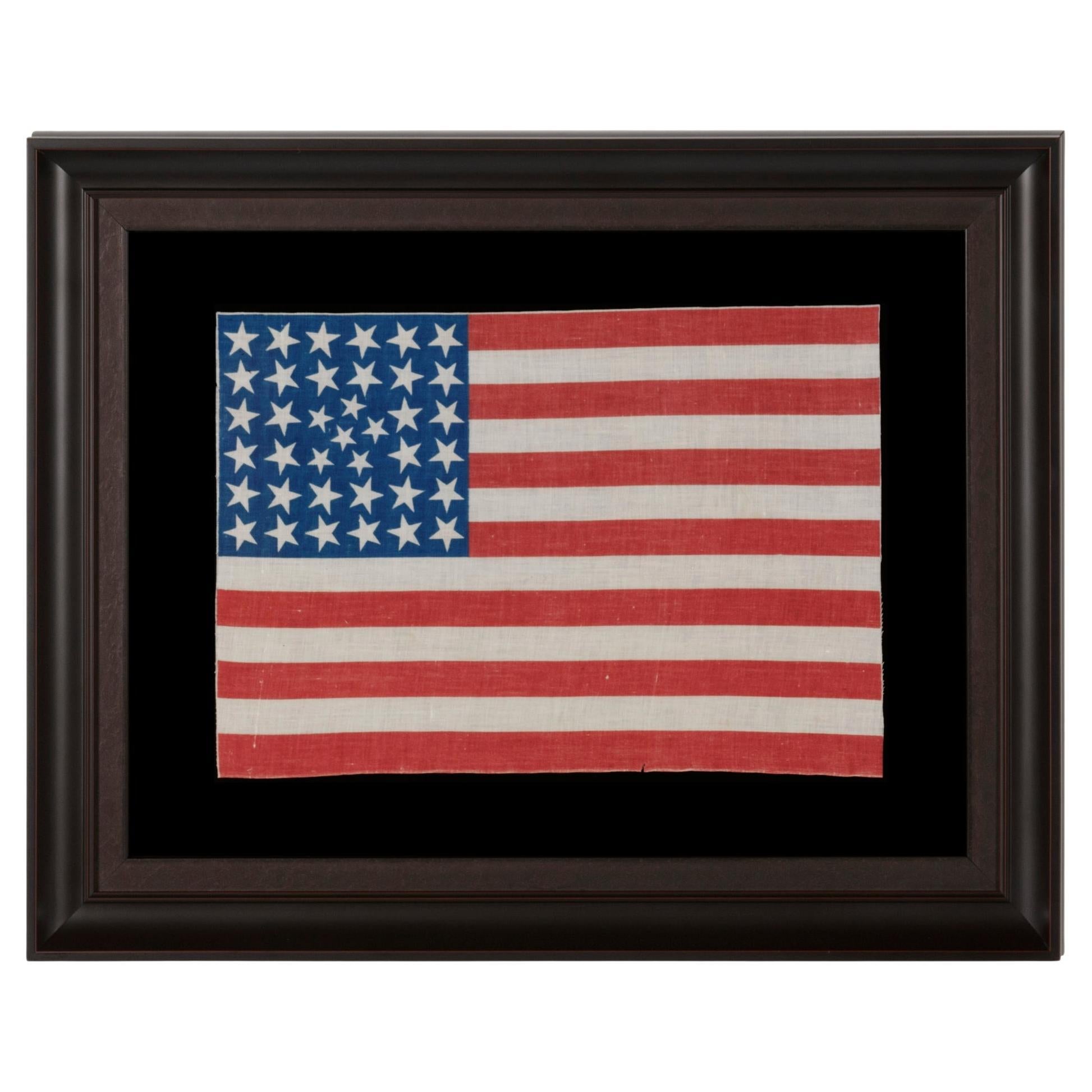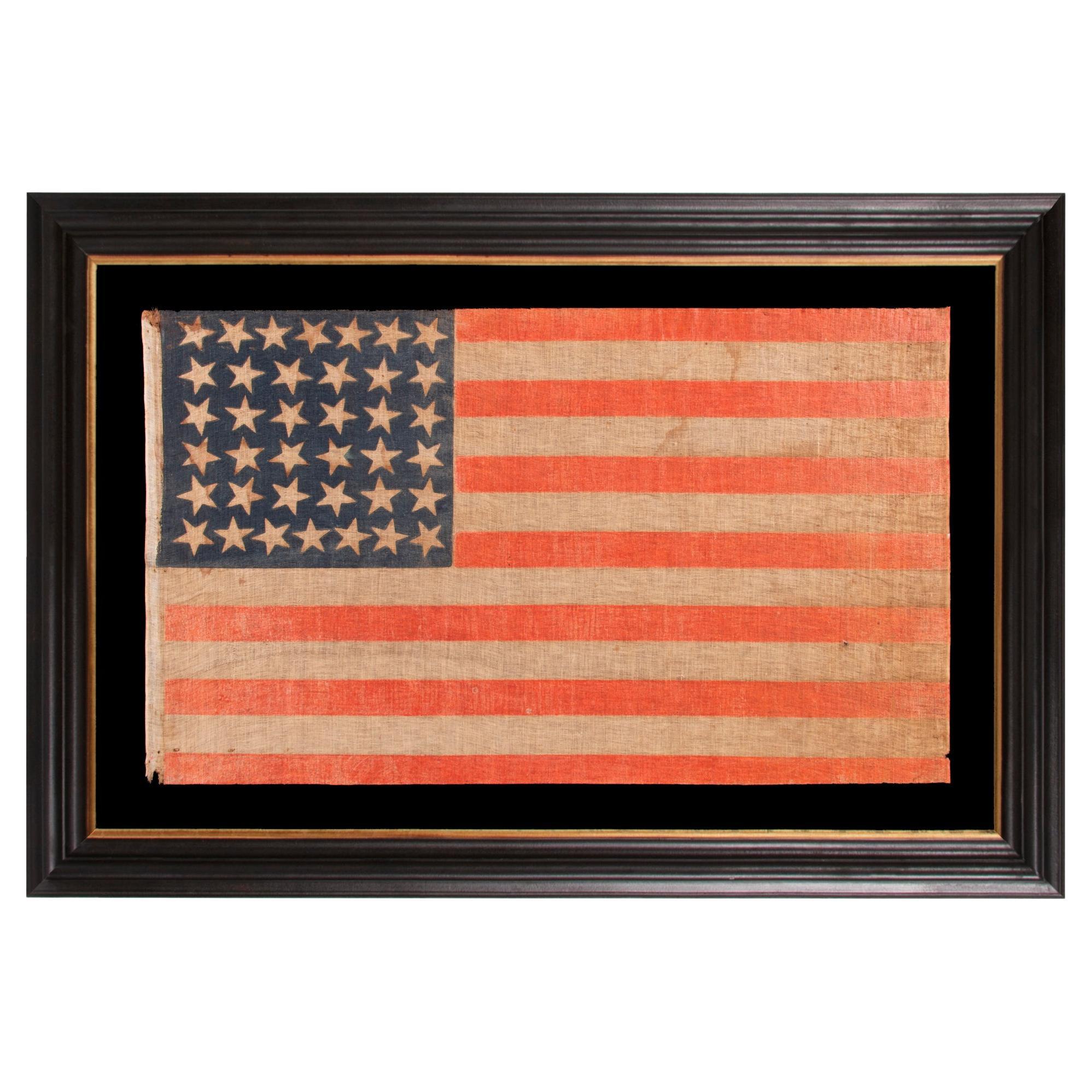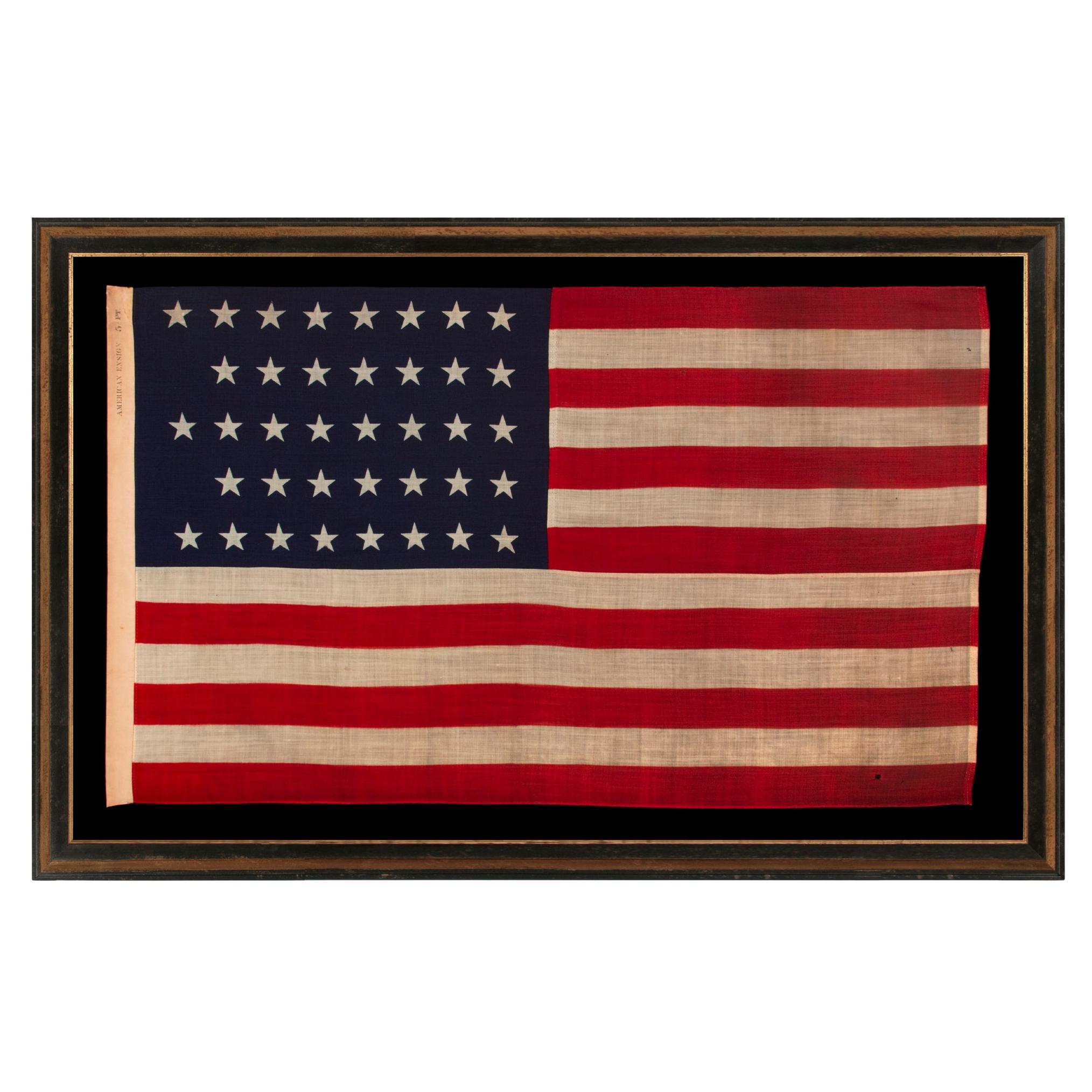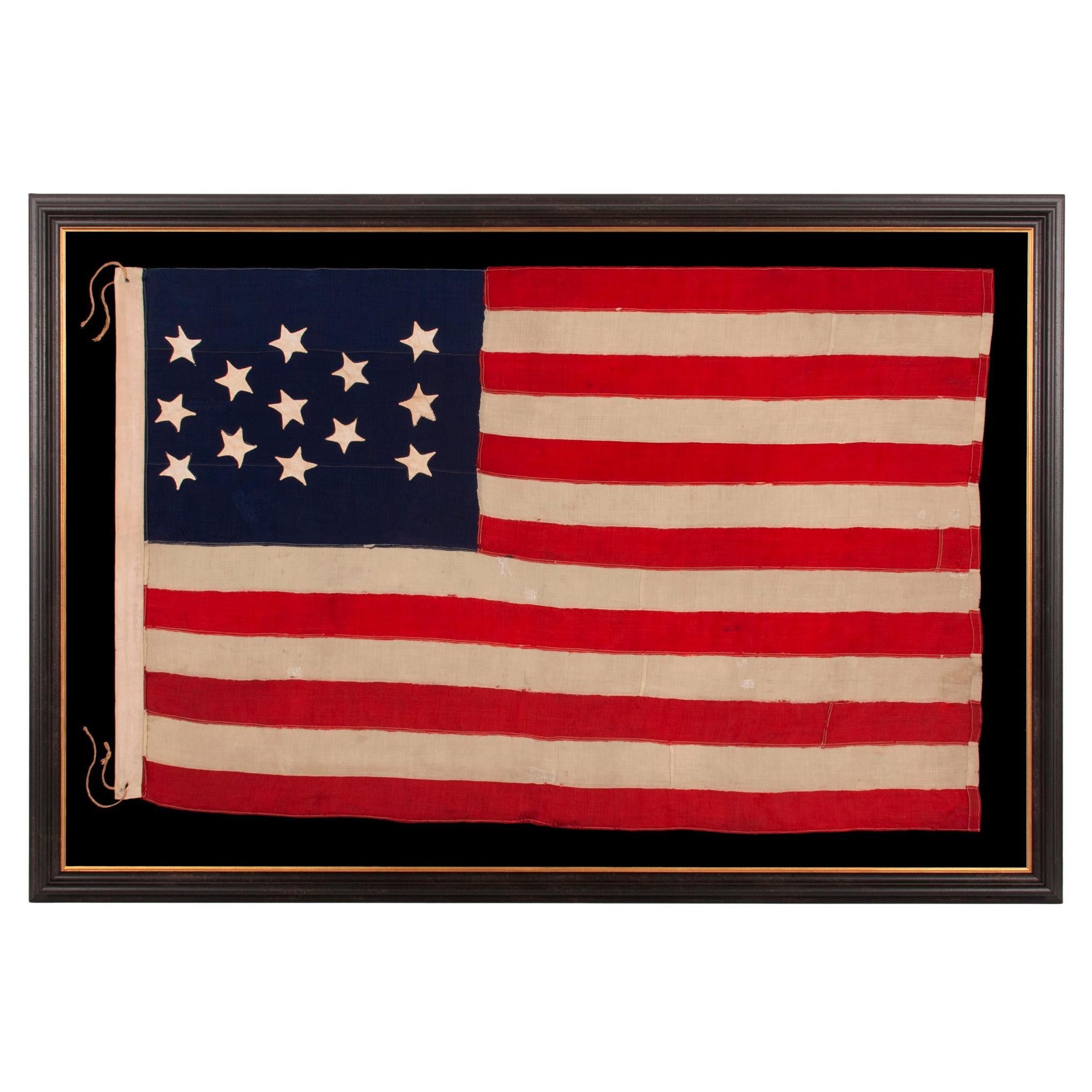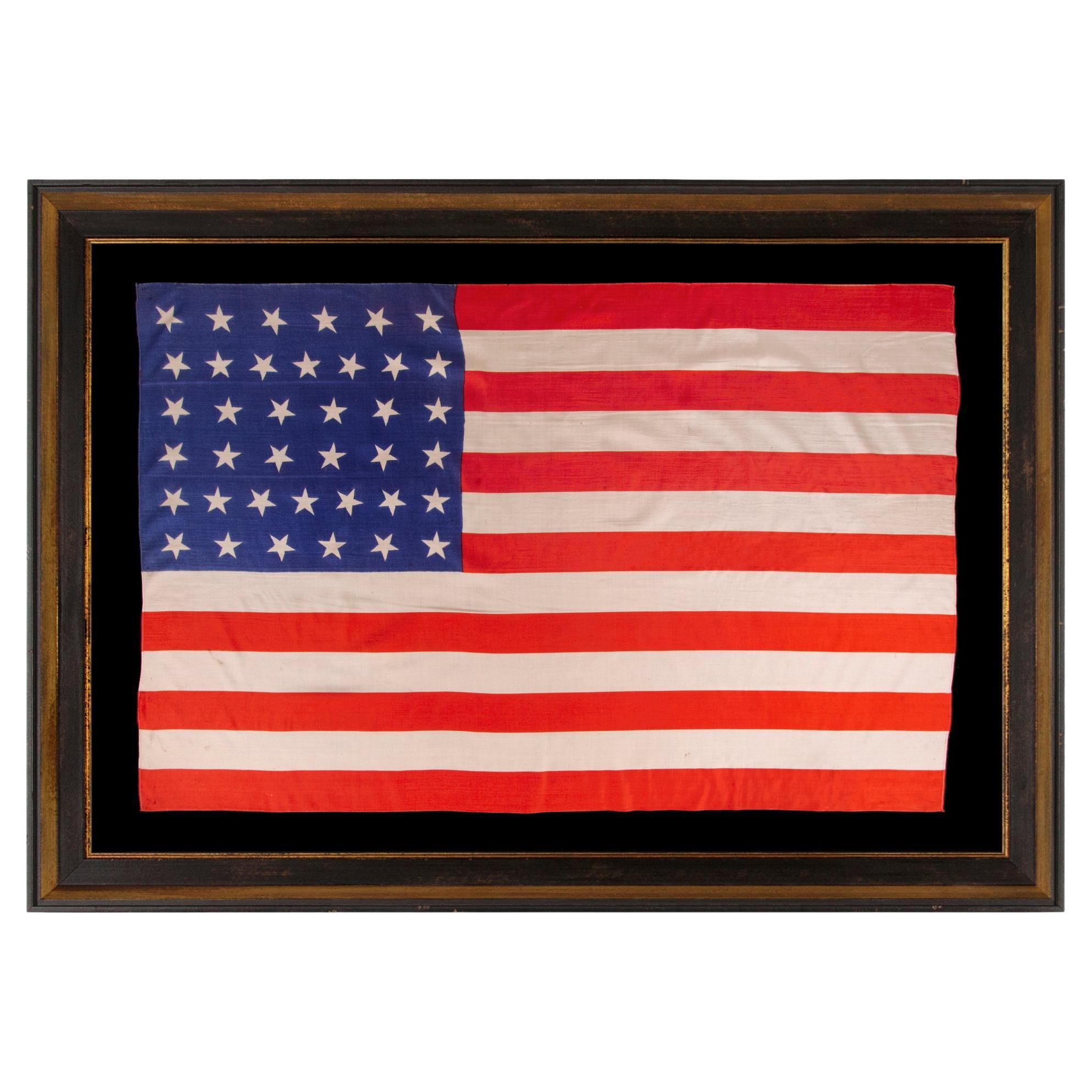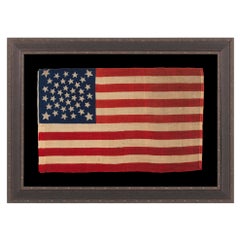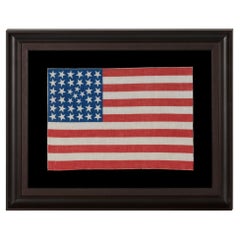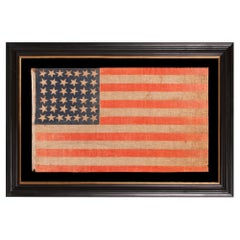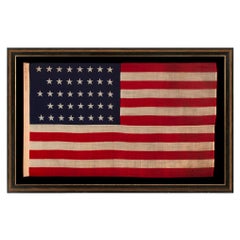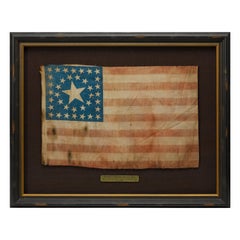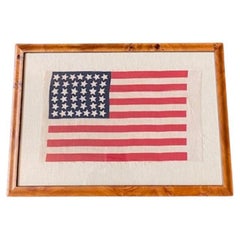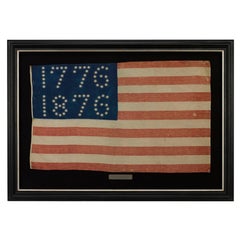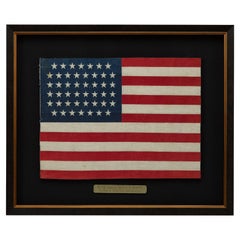Objekte ähnlich wie 38 Star Rare Circle in A Square Horstmann Brothers Made American Flag, ca 1876
Möchten Sie mehr Bilder oder Videos?
Zusätzliche Bilder oder Videos von dem*der Anbieter*in anfordern
1 von 5
38 Star Rare Circle in A Square Horstmann Brothers Made American Flag, ca 1876
Angaben zum Objekt
38 STARS IN A RARE AND STRIKING CIRCLE-IN-A-SQUARE MEDALLION, WITH AN ENORMOUS CENTER STAR, MADE FOR THE 1876 CENTENNIAL CELEBRATION BY HORSTMANN BROTHERS OF PHILADELPHIA, A MAJOR MILITARY OUTFITTER
38 star American national parade flag, press-dyed on wool bunting, with an especially rare type of medallion star pattern that consists of a huge center star, surrounded by a wreath of stars, with a square of stars around the perimeter. This design is significantly more rare than the equally beautiful “great star” pattern (a star made out of stars), generally thought of as the Rolls Royce of configurations among 19th century designs. Circle-in-a-square patterns are so scarce that even major collectors like Boleslaw Mastai, who wrote the first major text on flag collecting and owned more than 600 flags and flag-related objects, was evidently never fortunate enough to acquire one.
Many fantastic star patterns were made in the patriotism that accompanied or nation’s 100-year anniversary of independence in 1876 and this is among the best of all examples. Note how the vertical alignment of the stars varies greatly, but that the center star, as well as the stars in the left and right columns, all have one point directed upright. There were no regulations concerning either star configuration or position until 1912, and many flag-makers went out of their way to catch the attention of potential buyers.
The flag was made by Horstmann Brothers, a major Civil War military outfitter. I have owned examples of this precise and extremely scarce variety, on which the Horstmann name was printed. Due to the fact that the company was located in Philadelphia, and that the Centennial International Exposition—our nation's first major World’s Fair, which served as the nucleus of the national celebration—took place in the same city, in 1876, it is logical to assume that Horstmann supplied these flags to be displayed there. Photos of them, actually in use at the Expo, survive from two locations, one in a fan of flags (3 displayed) emerging from a patriotic shield, just to the left of the pavilion of Philadelphia map and print publisher Augustus Mitchell, high up on post #Q78, in the Main Building, and another from within the display of the AM District Telegraph Company (2 displayed, precise location unknown).
Note the attractive, royal blue color of the canton. Most known Horstmann examples in this rare design have much darker coloration. Sometimes there is a formal binding along the hoist of this style of flag, and sometimes not. In this case, both the hoist and fly ends are simply hemmed with treadle stitching. A series of small tack holes along the hoist, with small, associated rust stains, demonstrates how it was affixed to a wooden staff, with metal tacks.
Press-dyed wool flags are scarcer than those printed on cotton and silk. Because parade flags were often intended for one day's use at a parade, political rally, a reunion of soldiers, or some other patriotic event, most were made of cotton. While cotton absorbs water, short-term use precluded the need for anything more hardy. Because the Centennial Exposition lasted for a period of six months, it required decorative flags that would sustain being flown for a longer time and withstand the elements. Because wool sheds water, it was the fabric of choice selected by flag-makers for extended outdoor use. Prior to this time, press-dyed wool flags primarily served military function. With the advent of lengthy World’s Fair events in America, they were well-suited for the long-term, decorative applications these required and adapted as such.
Colorado became the 38th state on August 1st, 1876. This was the year of our nation’s 100-year anniversary of independence. Per the Third Flag Act of 1818, stars were not officially added until the 4th of July following a state's addition. For this reason, 37 was the official star count for the American flag in 1876. Flag-making was a competitive venture, however, and few flag-makers would have continued to produce 37 star flags when their competitors were making 38’s. It is for this reason that 38 and 13 stars (to represent the original 13 colonies) are more often seen at the Centennial Expo.
Some flag-makers would have been adding a star for the 38th state even before it entered the Union, in the early part of 1876 or even prior. In fact, many makers of parade flags were actually producing 39 star flags, in hopeful anticipation of the addition of two more Western Territories instead of one. But the 39th state would not join the Union for another 13 years, when the Dakota Territory entered as two states on the same day. The 38 star flag became official on July 4th, 1877 and was generally used until the addition of the Dakotas in 1889.
A Brief History of the Horstmann Company:
William H. Horstmann (1785-1850) was the founder of what would become a major military outfitter in both Philadelphia and New York City. A solider and fourth generation passementier (textile weaver), Horstmann emigrated to the United States from Cassel, Germany in either 1815 or 1816, settling in the Germantown area of Philadelphia, where there was a significant concentration of textile manufacturing. Horstmann established a business of manufacturing fringe, laces, and trimmings at 50 N. Third St. and soon after married the daughter of Frederick Hoeckly, the most successful lace manufacturer in the city. In 1824 he introduced three significant tools to America, including the first jacquard loom, for weaving multicolored fabrics, the first braiding machine, and a machine for plating metal. Moving to the corner of 59th & Third, he imported technology from Germany and elsewhere and maintained regular trade with his family in Europe. The company grew exponentially in size and had many addresses over its years of operation
In 1828, the William H. Horstmann Military Store opened and in 1831 he established a New York branch. In 1843 the name was changed to the William H. Horstmann & Sons Military Store, and in 1859 it was taken over by sons Sigmund H. and William J., who operated the business as Horstmann Bros. & Co. in both New York and Philadelphia. Taking on investors in the interim, from 1845-1849 it operated in NYC as Horstmann Sons & Drucker, then Horstmann Sons & Allien. As an outfitter of Civil War regiments, the firm manufactured its own goods, including flags, swords, drums, insignia, and many other items, and subcontracted for the manufacture of these objects as well, depending on financial sensibility. There were other investors and partners along the way, such as William S. Hassall and George Evans, who broke off and became a significant competitor as “Hassall & Evans.” Brothers Sigmund & William Horstmann passed in 1870 and 1872, respectively.
In 1877, the New York branch changed its name to that of partner H.V. Allien. In 1893 the Philadelphia location changed its name to simply “Wm. H. Horstmann Co.,” operating as such until 1940. In 1927 “Horstmann Uniform Co.” was established as a separate entity, though it operated in a building within the large, Horstmann campus. In 1948, both the Philadelphia and New York branches filed for bankruptcy and closed.
Mounting: The flag was mounted and framed within our own conservation department, which is led by expert trained staff. We take great care in the mounting and preservation of flags and have framed thousands of examples.
The background is 100% cotton twill, black in color, that has been washed and treated for colorfastness. The mount was placed in a gilded molding of exceptional quality, with a traditional, American profile, to which a step-down profile, shadowbox depth molding, with a very dark brown finish, almost black, with reddish undertones and highlights, was added as a cap. The glazing is U.V. protective acrylic (Plexiglas). Feel free to contact us for more details.
Condition: In addition to the aforementioned tack holes and associated rust stains along the hoist, there is a tiny moth hole in the canton and a few in the striped field, accompanied by a couple of extremely minor stains. Overall exceptional for a wool flag of the period, with extremely strong color.
Frame Size (H x L): 30" x 39.75"
Flag Size (H x L): 19" x 28.75"
Anbieterinformationen
5,0
Anerkannte Anbieter*innen
Diese renommierten Anbieter*innen sind führend in der Branche und repräsentieren die höchste Klasse in Sachen Qualität und Design.
Gründungsjahr 1991
1stDibs-Anbieter*in seit 2008
69 Verkäufe auf 1stDibs
Typische Antwortzeit: 1 bis 2 Tage
- VersandAngebot wird abgerufen …Versand von: York County, PA
- Rückgabebedingungen
Einige Inhalte dieser Seite wurden automatisch übersetzt. Daher kann 1stDibs nicht die Richtigkeit der Übersetzungen garantieren. Englisch ist die Standardsprache dieser Website.
Authentizitätsgarantie
Im unwahrscheinlichen Fall eines Problems mit der Echtheit eines Objekts kontaktieren Sie uns bitte innerhalb von 1 Jahr für eine volle Rückerstattung. DetailsGeld-Zurück-Garantie
Wenn Ihr Objekt nicht der Beschreibung entspricht, beim Transport beschädigt wurde oder nicht ankommt, kontaktieren Sie uns bitte innerhalb von 7 Tagen für eine vollständige Rückerstattung. DetailsStornierung innerhalb von 24 Stunden
Sie können Ihren Kauf jederzeit innerhalb von 24 Stunden stornieren, ohne jegliche Gründe dafür angeben zu müssen.Geprüfte Anbieter*innen
Unsere Anbieter*innen unterliegen strengen Dienstleistungs- und Qualitätsstandards, wodurch wir die Seriosität unserer Angebote gewährleisten können.Preisgarantie
Wenn Sie feststellen, dass ein*e Anbieter*in dasselbe Objekt anderswo zu einem niedrigeren Preis anbietet, werden wir den Preis entsprechend anpassen.Zuverlässige weltweite Lieferung
Unsere erstklassigen Versandunternehmen bieten spezielle Versandoptionen weltweit, einschließlich individueller Lieferung.Mehr von diesem*dieser Anbieter*in
Alle anzeigen38 Star American Flagge, Colorado Statehood, hergestellt von Horstmann Brothers ca. 1876
38 STERNE, COLORADO STATEHOOD, EINE SELTENE UND SCHÖNE ANTIKE AMERIKANISCHE FLAGGE MIT EINEM MEDAILLONMUSTER UND 4 GROSSEN ECKENSTERNEN, AUF WOLLE GEFÄRBT, HERGESTELLT VON DEN GEBRÜD...
Kategorie
Antik, Spätes 19. Jahrhundert, amerikanisch, Politische und patriotische...
Materialien
Wolle
38-Sterne-Antike amerikanische Paradeflagge, Colorado Statehood, ca. 1876-1889
38 STERNE IN EINER ÄUSSERST UNGEWÖHNLICHEN ANORDNUNG, DIE EINE GRUPPE VON 6 KLEINEN STERNEN INNERHALB EINES LINIENMUSTERS GRÖSSERER STERNE AUFWEIST, 1876-1889, COLORADO STATEHOOD
Na...
Kategorie
Antik, Spätes 19. Jahrhundert, amerikanisch, Politische und patriotische...
Materialien
Baumwolle
38-Sterne-Antike amerikanische Paradeflagge, Colorado Statehood, ca. 1876-1889
38 STERNE ANTIKE AMERIKANISCHE PARADEFLAGGE MIT GERECHTFERTIGTEN REIHEN VON 7-6-6-6-6-7 UND VERSTREUTER STERNAUSRICHTUNG, HERGESTELLT WÄHREND DER ZEIT, ALS COLORADO DER JÜNGSTE STAAT...
Kategorie
Antik, Spätes 19. Jahrhundert, amerikanisch, Politische und patriotische...
Materialien
Baumwolle
38-Sterne antike amerikanische Flagge, Colorado Statehood, hergestellt in Massachusetts 1876-89
38 STERNE ANTIQUE AMERICAN FLAG MIT EINER GEKERBTEN KONFIGURATION, HERGESTELLT VON DER U.S. BUNTING COMPANY IN LOWELL, MASSACHUSETTS, REFLECTS THE ERA OF COLORADO STATEHOOD, ca. 1876...
Kategorie
Antik, Spätes 19. Jahrhundert, amerikanisch, Politische und patriotische...
Materialien
Wolle
13 Sterne Antike amerikanische Flagge mit einem schmalen Stern Präsentation, ca. 1876
ANTIKE AMERIKANISCHE FLAGGE MIT 13 STERNEN, HANDGENÄHT IN EINER EXTREM SCHMALEN 3-2-3-2-3-ANORDNUNG AUF EINEM KANTON, DER SICH NICHT AN DIESE ANORDNUNG HÄLT UND OBEN UND UNTEN WEITE ...
Kategorie
Antik, 1870er, amerikanisch, Politische und patriotische Erinnerungsstücke
Materialien
Wolle
38 Stern Antike amerikanische Flagge, Colorado Statehood, ca. 1876-1889
38 Sterne, antike amerikanische Paradeflagge mit verstreuten Sternen, aus Seide, mit großzügigem Maßstab und lebhaften Farben, Colorado Statehood, 1876-1889
Nationale amerikanisch...
Kategorie
Antik, Spätes 19. Jahrhundert, amerikanisch, Politische und patriotische...
Materialien
Seide
Das könnte Ihnen auch gefallen
38-Star Antike amerikanische Flagge mit einzigartigem Kanton, ca. 1876-1890
Dies ist eine auffällige amerikanische Flagge mit 38 Sternen. Die Flagge stammt aus den Jahren 1876-1890, als Colorado (dargestellt durch den großen Stern in der Mitte des Kantons de...
Kategorie
Antik, Spätes 19. Jahrhundert, amerikanisch, Politische und patriotische...
Materialien
Musselin
Amerikanische 38-Sterne-Paradefahne, ca. 1877
Antike amerikanische 38-Sterne-Paradeflagge, um 1877, eine kleine Paradeflagge aus feinem gewebtem Leinen mit 38 Sternen in einem kühnen "Dancing Star"-Muster, das 1877 bei der Aufna...
Kategorie
Antik, 1870er, amerikanisch, Federal, Politische und patriotische Erinne...
Materialien
Leinen
Centennial Celebration „1776-1876“ Amerikanisches Flaggenbanner
Präsentiert wird eine seltene patriotische Hundertjahrfeier-Fahne aus dem Jahr 1876. Der leuchtend blaue Kanton der Flagge ist spektakulär, mit 81 fünfzackigen, strahlenförmigen Ster...
Kategorie
Antik, 1870er, amerikanisch, Politische und patriotische Erinnerungsstücke
Materialien
Wolle, Baumwolle
46-Sterne-Flagge der amerikanischen Flagge gedruckt in Trommelstern-Konfiguration
Dies ist eine originale amerikanische 46-Sterne-Paradeflagge zur Feier der Staatsgründung Oklahomas. Jeder Stern im Kanton der Flagge steht für einen Staat, der damals zur Union gehö...
Kategorie
Vintage, 1910er, amerikanisch, Politische und patriotische Erinnerungsst...
Materialien
Seide
38-Sterne-Flagge der amerikanischen Paradeflagge, geschmückt bei einer Ankunft für das Präsidentenstipendium, 1880
Dies ist eine wunderschön gefärbte amerikanische Paradeflagge mit 38 Sternen, die bei einem öffentlichen Empfang für Ulysses S. Grant im Oktober 1880 gehisst wurde. Diese gedruckte F...
Kategorie
Antik, 1880er, amerikanisch, Politische und patriotische Erinnerungsstücke
Materialien
Baumwolle
Antike amerikanische Flagge mit 39-Stern-Muster und skurrilem Sternmuster, 1889
Dies ist eine inoffizielle amerikanische Flagge mit 39 Sternen, handgefertigt und auf Baumwolle gedruckt. Die Flagge stammt aus dem Jahr 1889 und hat dank ihrer seltenen Sternenzahl ...
Kategorie
Antik, 1880er, amerikanisch, Politische und patriotische Erinnerungsstücke
Materialien
Baumwolle
